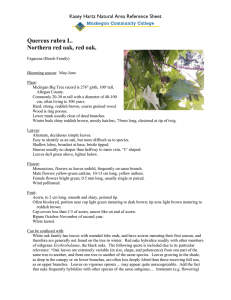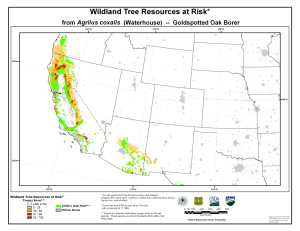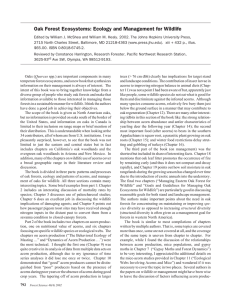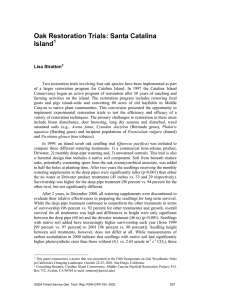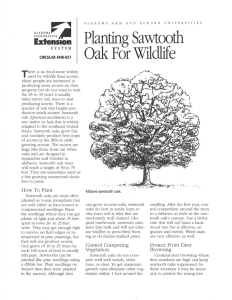Quercus velutina Black oak Kasey Hartz Natural Area Reference Sheet
advertisement
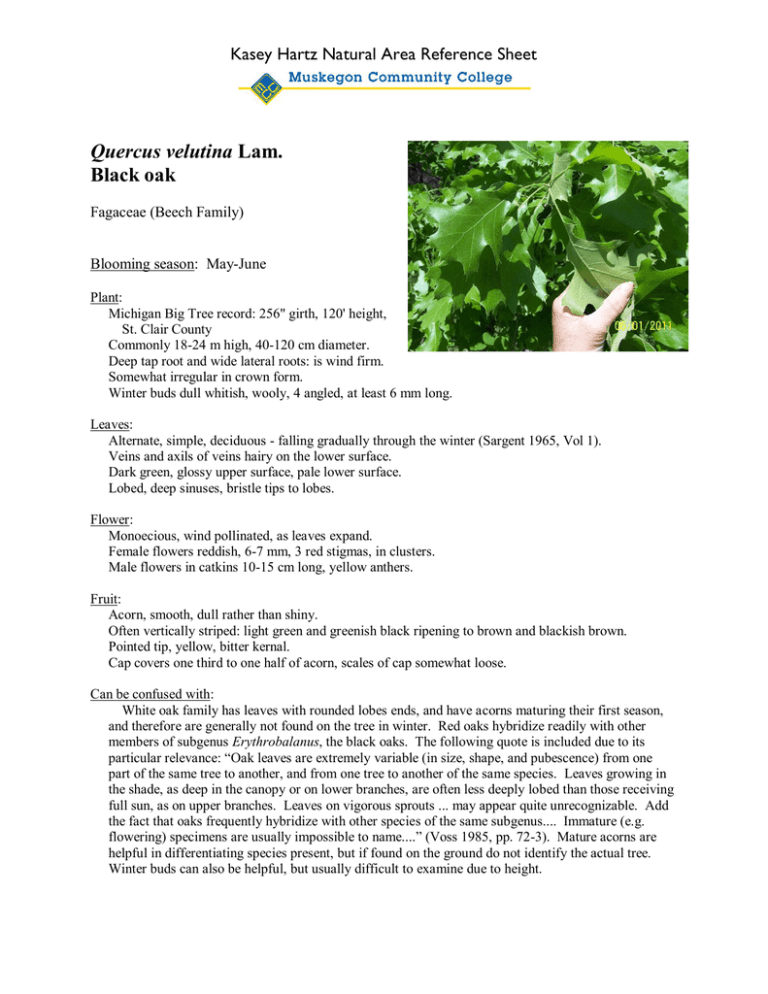
Kasey Hartz Natural Area Reference Sheet Quercus velutina Lam. Black oak Fagaceae (Beech Family) Blooming season: May-June Plant: Michigan Big Tree record: 256" girth, 120' height, St. Clair County Commonly 18-24 m high, 40-120 cm diameter. Deep tap root and wide lateral roots: is wind firm. Somewhat irregular in crown form. Winter buds dull whitish, wooly, 4 angled, at least 6 mm long. Leaves: Alternate, simple, deciduous - falling gradually through the winter (Sargent 1965, Vol 1). Veins and axils of veins hairy on the lower surface. Dark green, glossy upper surface, pale lower surface. Lobed, deep sinuses, bristle tips to lobes. Flower: Monoecious, wind pollinated, as leaves expand. Female flowers reddish, 6-7 mm, 3 red stigmas, in clusters. Male flowers in catkins 10-15 cm long, yellow anthers. Fruit: Acorn, smooth, dull rather than shiny. Often vertically striped: light green and greenish black ripening to brown and blackish brown. Pointed tip, yellow, bitter kernal. Cap covers one third to one half of acorn, scales of cap somewhat loose. Can be confused with: White oak family has leaves with rounded lobes ends, and have acorns maturing their first season, and therefore are generally not found on the tree in winter. Red oaks hybridize readily with other members of subgenus Erythrobalanus, the black oaks. The following quote is included due to its particular relevance: “Oak leaves are extremely variable (in size, shape, and pubescence) from one part of the same tree to another, and from one tree to another of the same species. Leaves growing in the shade, as deep in the canopy or on lower branches, are often less deeply lobed than those receiving full sun, as on upper branches. Leaves on vigorous sprouts ... may appear quite unrecognizable. Add the fact that oaks frequently hybridize with other species of the same subgenus.... Immature (e.g. flowering) specimens are usually impossible to name....” (Voss 1985, pp. 72-3). Mature acorns are helpful in differentiating species present, but if found on the ground do not identify the actual tree. Winter buds can also be helpful, but usually difficult to examine due to height. Kasey Hartz Natural Area Reference Sheet Quercus velutina Lam. Black oak 2 Geographic range: Type specimen location: State: Lower 2/3 of state. Regional: Southern Maine and Ontario, southern Lower Peninsula of Michigan, west to eastern Kansas, south to Florida and across to Texas. Habitat: Local: Upland and on west facing slope. Regional: Dry, often sandy soils. Frequently with pine or hickory. Common local companions: Other oaks, sassafras, bracken fern, huckleberry, and blueberry. Usages: Human: Native Americans used acorns as food, after leaching tannin out. The bark was used to make a reddish-yellow dye and in the process of tanning. It also had many medical uses: as a febrifuge; eyewash; astringent; emetic; treatment for chronic dysentery; for sore, chapped skin; asthma; hoarseness; “female trouble”; antiseptic; it was also chewed for mouth sores. After powdering the bark, it was used as a dentifrice. The wood was used in basketry. The European colonists used the inner bark for yellow and green dyes (depending on mordant), and large quantities were exported to Europe until the 1940's for that purpose. The wood has long been used for construction and firewood, being dense and hard. The wood is often sold as red oak for furniture and paneling. Other animal: Although not as favored as white oak, the acorns are readily eaten by deer, wild turkeys, squirrels, chipmunks, raccoons, black bears, grouse, and blue jays. Acorns form a very important winter food source, constituting “a good and abundantly available staple”: which is why they appear on so many favorite food lists of animals (Martin et al p. 308). Periodical cicadas prefer its twigs, along with other oaks, to lay their eggs on. The gypsy moth also prefers oaks for nurseries. Various moths, flies, and wasps lay eggs on or in leaves, twigs and acorns; some lay on leaves and twigs result in galls forming. Why is it called that? Quercus is old Latin for the name of a specific European oak. Velutina is Latin for velvety, referring to its winter buds. Oak is the Anglo-Saxon word for oak tree. Prepared by: Barbara Lukacs Grob April 2008
